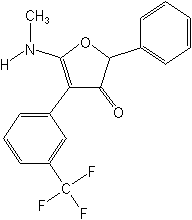-
Common NameFlurtamone
-
中文通用名呋草酮
-
IUPAC(RS)-5-methylamino-2-phenyl-4-(α,α,α-trifluoro-m-tolyl)furan-3(2H)-one
-
CAS5-(methylamino)-2-phenyl-4-[3-(trifluoromethyl)phenyl]-3(2H)-furanone
-
CAS No.96525-23-4
-
Molecular FormulaC18H14F3NO2
-
Molecular Structure
-
Category
-
ActivityFlurtamone is primarily a pre-emergence or pre-plant incorporated herbicide. It is absorbed through roots and shoots causing immediate chlorosis. After application, the product remains near the surface of the soil and is available to be taken up by roots for some weeks afterwards. The product has some post-emergence activity; this is improved by the use of adjuvants. A humid environment at the time of treatment allows for lower application rates.
Some transient phytotoxicity on young cereal leaves, especially wheat, has been reported. Trials are on-going to determine its safety to other vegetables and sorghum. -
CropUseCropUses:
Cereals, vegetables (including peas and potatoes), sunflowers, cotton, peanuts
Cereals
250/375 g ai/ha
Sunflowers
250/375 g ai/ha
-
PremixFlufenacet+Diflufenican+Flurtamone
Type
AI concn
50% (w/w)
Wettable powder (WP) ,Water-dispersible granule (WG), Suspension concentrate (SC)
Premix Parters: mancozeb; propiconazole;
-
Physical PropertiesMolecular weight:333.3; Physical form:Ivory powder. Melting point:152-155 °C; Solubility:In water 35 mg/l (20 °C). Soluble in acetone, dichloromethane, methanol; slightly soluble in isopropanol.; Stability:Stable, but avoid concentrated acids or bases.
-
ToxicologyOral:Acute oral LD50 for rats 500 mg/ kg. Percutaneous:Acute percutaneous LD50 for rabbits 500, rats >5000 mg/kg. Non-irritating to skin and transient eye irritant (rabbits). Phytotoxicity:Transitory bleaching effect. ADI:Not used on food crops.
-
Environmental ProfileEcotoxicology:
Bees: LD50 (48 h, contact) >100 μg/bee. Birds: LC50 for bobwhite quail >6000, mallard ducks 2000 mg/kg diet.Fish: LC50 (96 h) for bluegill sunfish 11, rainbow trout 7 mg/l.
Environmental fate:
Soil:Field DT50 46-65 d; the main metabolite is trifluoromethylbenzoic acid. Moderately adsorbed on soil colloids; flurtamone residues remained in the upper 20 cm, and the metabolite in the upper 10 cm of soil. No residues of either Plant:No residues in peanuts and in cereals at harvest. -
Transport InformationSignal Word:CAUTION; Hazard Class:III(Slightly hazardous)
Porduct NewsMore
EU to phase out fungicides quinoxyfen, propiconazole and herbicide flurtamone
Quinoxyfen Propiconazole Flurtamone

 0
0 Subscribe
Subscribe
